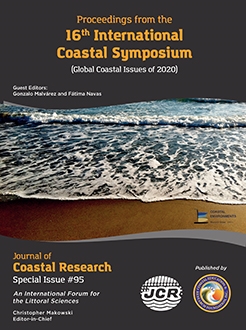Jiang, Z.; Shi, L.; Guo, J., and Zhang, M., 2020. Storm response and recovery process after nourishment of Dongsha Beach, Zhujiajian Island, Zhejiang Province. In: Malvárez, G. and Navas, F. (eds.), Global Coastal Issues of 2020. Journal of Coastal Research, Special Issue No. 95, pp. 231-236. Coconut Creek (Florida), ISSN 0749-0208.
Effective beach nourishment can reduce storm-related erosion and promote beach recovery after storms. Herein the Dongsha Beach Nourishment Project is presented as an example. Topographic survey data and sediment samples were obtained immediately before and after the landing of Typhoon Talim (tropical storm No. 1718) in 2017 and again one, two, and six months later. The digital elevation model (DEM), beach profiles, and sediment particle sizes were used to analyze the initial response of Dongsha Beach and its recovery process. The project was compared to 16 other beach nourishment projects in China to assess its effectiveness. Talim eroded the beach as a whole, although erosion was most severe in the lower headland sheltered section and the straight section. The upper headland sheltered section suffered the least erosion and recovered most during the recovery period, followed by the straight section. The lower headland sheltered section showed the least recovery. Talim coarsened grains in the straight and upper headland sheltered sections. Grains in the high tide zone in the lower headland sheltered section appeared coarsened, while grains in the middle and low tide zones were refined. Sedimentary grains in the upper headland sheltered and straight sections returned to their pre-typhoon states within the first and second months of the recovery period, respectively. The lower headland sheltered section had not recovered after six months. The fastest recovery o ccurred within the low tide zone. Recovery in the mid-tide zone followed, while the high tide zone recovered most slowly. When Dongsha Beach was compared to 16 other beaches in China, the 2017 nourishment project appeared to be inefficient. However, high stability and good natural conditions will enable better results to be achieved at Dongsha Beach with scientific planning.





